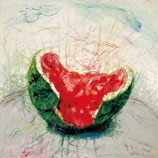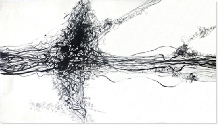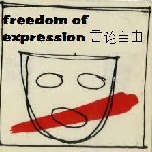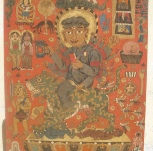


His series of mask are really carefully, the lines are thin and the subjects funny. The mix of colours “pastel” also. Not less interesting is his series of portraits or landscapes upper lined with full of lines.
Probably is one of the artist who try to find several directions in his art.
His works for The Sanya collection are more abstract, but probably following the idea of his last works: the lines, and older ones like watermelon like “icona”. They are also his first works on ink, therefore I think he has done an effort to give us something to think about.
This untitled ink on paper work are a magnificent and rare example of artist Zeng Fanzhi's iconic and immediately recognizable expressionistic style. At times faint and wandering, at others aggressive and definite, the dynamic and complex bundle of lines that slowly unravel across the page, are a testament to the artist's experiments with subconscious expression through an 'automated' process.
Evoking Zeng's landscape paintings, in which the artist uses one hand to create his subject while simultaneously using his other hand in an automatic fashion, this work conveys Zeng's meditative and subconscious working method. While the artist has made other ink on paper works, this is the only abstract work on paper by the artist to ever come to auction. Ultimately, this drawing encapsulates the psychological tension for which Zeng is famous, and is a rare and stunning testament to the imagination and emotional range of the artist.
March 2008 I discovered an oil on canvas similar to the Sanya collection inks. The work was dated 2004, untitled no.5, 40x135. It’s clear the interest of Zeng to experiment the ink for one of his series of oil pictures, the Pond.
Only another work in ink datid 2005 and 40x70cm appear in 2011 in artnet.
The watermelon says “eat me”. But not only:
"Watermelon", ZENG Fanzhi's works in 2004 has strong symbolic implication. The cut open red pulp associates with silent violence and protest, extending previous claiming of topics like Peking Union Medical College Hospital, mask, etc. Image of watermelon has once appeared in his early self-portrait or in the theme of Last Supper, symbolizing blood and flesh. Here, the independently existing "Watermelon" presents the full visual sense resembling silentmonolog of the painter.











